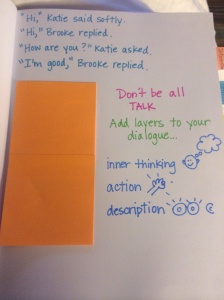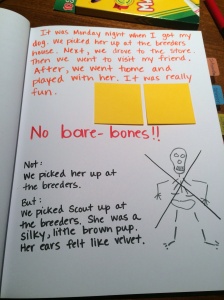It’s always been a dream of mine to become a writer. Funny thing is, I’ve never actually viewed myself as a writer- so I suppose it’s an odd dream… In June, I spent a week in New York at Teacher’s College learning from some of the most brilliant minds! A theme that kept coming back to me was, to teach writers we need to be writers.
I was incredibly uncomfortable whenever we were asked to write, because I knew a share would be following it up. But like everyone, I just did it, and it got easier by the end of the week. I realized I wasn’t the only one who felt this way. Many others shared the same feelings of inadequacy as a writer, and consequently, as a teacher of writing.
So here I am! With the encouragement of some great leaders, I am starting my first blog. In doing so, I am building my writing life while sharing ideas with others both near and far. I hope you find these ideas and resources helpful. In return, please comment and share any ideas you might have. I’m always looking to grow my resources!
During the institute I worked alongside Katie Clements. If you don’t already follow her on Twitter, you should follow her @clemenkat. She is a wonderful resource to teachers! I attended a closing workshop run by her on creating toolkits for writing; specifically conferring and small group work. To say I was inspired would be a huge understatement! That day, I went to the bookstore, grabbed a sketchbook, some markers and I headed back to my hotel to get started on creating my own demonstration notebook.
Today, I am sharing some of the pages I have created for narrative writing. Some of the tips Katie gave us are:
- It doesn’t have to be perfect, if you make a mistake, cross it out.
- The text needs to mimic the writing your students write in sentence structure and length.
- Make it colorful.
- Give it a catchy title.
- Add some illustrations.
- Keep post-its on the page to give to students- they will seem more special.
- Just make the pages! (This goes back to my first point) If you spend too much time planning them, you will never make them and…you will never use the notebook.
Katie allowed us to take a few pictures of her notebook, but told us it would be more powerful if we came up with our own pages. Yes, there was a huge sigh when she told us this, but I have to say she was right. The process of writing my own text was harder than I thought it would be! I kept wanting to make the text more sophisticated, I really had to stop and think, “How would a third grader write this?” I realized, my text isn’t perfect but the kids reading it won’t have perfect text either, so….it works.
This was the first page I made- I won’t say created, because this was one of the pages Kate let us take a picture of. 🙂 I simply changed the text at the top.
This, I’m sure will be a page I use A LOT! Many kids struggle with adding too much dialogue in their writing. You can use the post-it notes to demonstrate how to add layers to dialogue. It’s up to you if you want to include all 3 ways on one page. You might want to make a separate page for each layer. This would definitely differentiate for students, especially if you teach younger children.
Give students the demonstration writing as a reminder to use this strategy in their writing. I’m going to have my students place the post-its on evidence of this work. (This goes for all of my demonstration pages.) This will save time “hunting” for this work when we meet again.
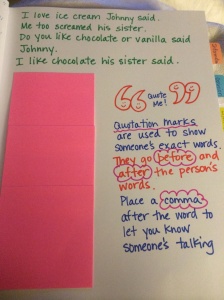 If your students don’t struggle with quotation marks, please share what you are doing! Mine always struggle with this! On this particular page, I am going to tape transparency film over the text so we can do this work together and I can erase it and use the page again…another hot tip from Katie!
If your students don’t struggle with quotation marks, please share what you are doing! Mine always struggle with this! On this particular page, I am going to tape transparency film over the text so we can do this work together and I can erase it and use the page again…another hot tip from Katie!
I lifted a sentence out of the text to demonstrate what it could sound like. With students I will lift another sentence out for practice. We will then move to their notebook to see where they can mimic this work.
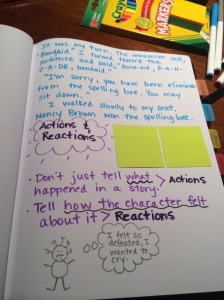 This page will be used to demonstrate how writers use inner thinking. I might even use some examples from our classroom to practice this skill with students first. For example, I might use the “action” of walking into the classroom for the first time. I could ask them what their “reaction” or inner thinking was at that moment, and do some oral rehearsing. Then move to the demonstration notebook to do this work in writing. Again, it really depends on the student or group you have in front of you.
This page will be used to demonstrate how writers use inner thinking. I might even use some examples from our classroom to practice this skill with students first. For example, I might use the “action” of walking into the classroom for the first time. I could ask them what their “reaction” or inner thinking was at that moment, and do some oral rehearsing. Then move to the demonstration notebook to do this work in writing. Again, it really depends on the student or group you have in front of you.
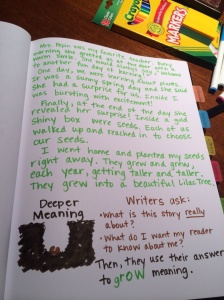 As I said earlier, the pages aren’t perfect! The text on this page is probably too long, but I can still use it and if it’s not working, always add a new page to this section. I wanted to try to get a story down from beginning to end that lacked real meaning. I found this to be hard without having a lot of text. The post-its are on the page next to it.
As I said earlier, the pages aren’t perfect! The text on this page is probably too long, but I can still use it and if it’s not working, always add a new page to this section. I wanted to try to get a story down from beginning to end that lacked real meaning. I found this to be hard without having a lot of text. The post-its are on the page next to it.
Well, that’s all for now! Stay tuned for more resources and tools to use with your students! But, before I go, thank you to Katie Clements for her inspiration, ideas and support in creating these pages! Also, to Fran McVeigh, who really encouraged me to start this blog!
You can follow Fran McVeigh on Twitter @franmcveigh and read her amazing HERE! She has some great information about building toolkits too!
